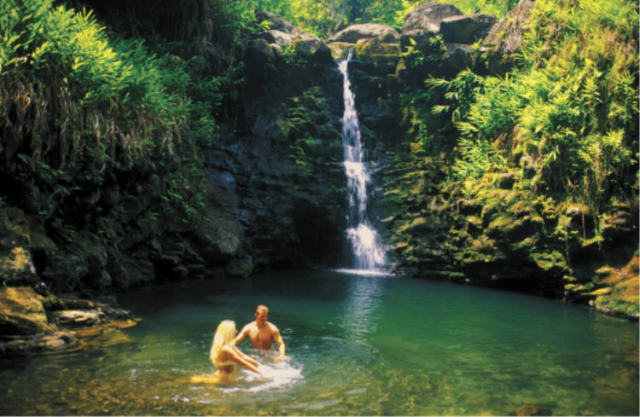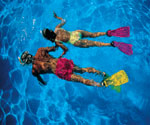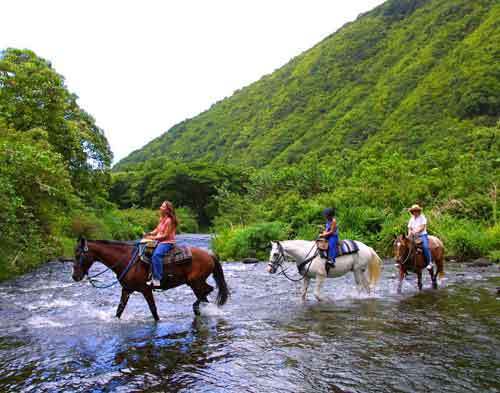Peaking at an elevation of 13,796 ft MSL, you can see the majestic Mauna Kea volcano from almost any point on the Big Island of Hawaii. Often in the winter, Mauna Kea will receive snow fall. The sight of a snow-capped volcano in the backdrop as you lounge on a sunny Kohala beach is truly spectacular. My favorite view is from the higher elevations of Waimea, with its green pastures and rolling hills in the foreground, and towering volcano in the background.
Although it is in plain sight, reaching is summit is not an easy task. The easiest way is to take the guided summit tour. Transportation is conveniently provided along with insightful narrative and telescopes for gazing through the clear cold sky to the heavens above.
If you want to drive there on your own, more than likely you are renting a car and that is a disqualifier. You will be able to reach the Onizuka Visitor’s Center at 9,000 feet, but no further. That is because from here the road is a windy, rough, 4×4-only dirt road, and regular rental vehicles are prohibited (even if you rent an SUV). I mention regular rental vehicles - that is because there is one company on the island that rents *special* vehicles for you to traverse the more rugged portions of the island.
Harper Truck Rentals offers 4WD vehicles that can take you to the top of Mauna Kea, as well as into the Waipio Vallley, and other remote 4×4-only destinations on the island. On this particular occasion, we rented a Toyota 4Runner from Harper and drove the saddle road from Hilo. We turned north at the Mauna Kea Access Road (near the 28-mile marker) and drove 6 miles to the Onizuka Visitor’s Center. You can reach the visitor’s center in any vehicle, however you cannot continue to the summit from here without 4WD. It is a good idea to rest at the visitor’s center for about 30 minutes to help acclimate yourself to this high altitude.
We stopped to tour the visitor’s center and then continued on up the windy, loose-gravel road to the summit. The month was December and there was fresh snow on the ground, so we drove slowly and with caution. The narrow road winds its way to the top and we could see expansive views of the island below as well as snow and ice that had accumulated on the cinder cone. We finally reached the end of the road. Up here, some of the world’s most powerful and important telescopes are operated by many international organizations. Canted off to the side is the tall cinder cone marking the actual Pu’u Wekiu summit of Mauna Kea. Eager to conquer this point, we departed the vehicle and trudged across the ice and snow towards the peak. If you come this far, make sure you dress warmly! Most visitors to Hawaii do not pack for 30-degree, icy weather, but luckily we were dressed for the occasion - jackets, warm layers, and gloves.
As we ascended this snow-capped peak, we hastened our pace in excitement, and forgetting about the above-10,000 foot altitude, out breathing became a little bit too heavy. Consequently, by the time we reached the peak, we felt a shortness of breath and some light-headedness. Any time a human is above 10,000 feet, there is cause for concern as the oxygen content here is significantly lower than at sea level. With less oxygen being inhaled, opportunities for hypoxia and even edema do exist. I quickly recognized these were all symptoms of hypoxia and that I needed to calm down and sit down - or else… So we took a lot of photos (which I subsequently lost and cannot find to this day) and returned to the truck to sit for a moment as I gathered my breath. Of course, we scooped up snow balls along the way and enjoyed the very unusual Hawaii scene.
There is one other way to reach the summit - although it is a physical challenge. That is to hike from the visitor’s center to the summit. That means ascending more than four thousand feet in elevation. The hike is a demanding 12 miles, round trip, and will take most or all of the day to accomplish. Details and maps are available at the visitor’s center. Someday I plan to do this hike - along with the very rigorous Mauna Loa summit hike. In the meantime, I need to search my house to find those missing photos of the Mauna Kea summit.
Descending back down on the windy gravel road is a challenge. The grade is steep and the road narrow. This is where the tough 4×4 sure comes in handy. Make sure you do not ride the brakes going down or you could end up with a bad situation. If you can, shift to a lower gear, or engage a downhill assist mode (Toyota truck feature). Fog can swoop in at any time on this road, making it even more dangerous than it already is.




 Hike
with an expert guide in Hawai'i Volcanoes National Park, in the rain
forests, deep in remote valleys, and explore hidden waterfalls
Hike
with an expert guide in Hawai'i Volcanoes National Park, in the rain
forests, deep in remote valleys, and explore hidden waterfalls
 Enjoy
a picturesque Hawaiian horseback ride through the Valley of the
Kings, a lush tropical paradise of jungle trails, waterfalls, and spiritual sites.
Enjoy
a picturesque Hawaiian horseback ride through the Valley of the
Kings, a lush tropical paradise of jungle trails, waterfalls, and spiritual sites.

Great article. I’ve gone up Mauna Kea before, and I’ve been meaning to do it for awhile now. I’ll probably check it out sometime this year. Your tips will definitely be used.
Dale,
Enjoy your trip! It has been several years since I went and after writing this blog entry, I really want go back. I wish I could find all of my old photos that I took at the top of the mountain.